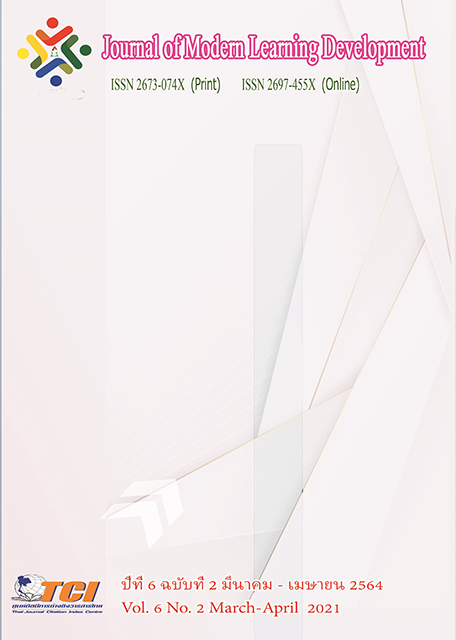การจัดการมรดกทางวัฒนธรรมอย่างสร้างสรรค์โดยการมีส่วนร่วม ของชุมชนลุ่มน้ำโขง
Main Article Content
บทคัดย่อ
บทความวิจัยนี้ มีวัตถุประสงค์เพื่อ 1) เพื่อสร้างองค์ความรู้ด้านประวัติศาสตร์ วัฒนธรรมประเพณีของชุมชนลุ่มน้ำโขง 2) ศึกษารูปแบบการจัดการมรดกทางวัฒนธรรมอย่างสร้างสรรค์โดยการมีความร่วมของชุมชนลุ่มน้ำโขง 3) สร้างจิตสำนึกในการอนุรักษ์ รักษามรดกทางวัฒนธรรมประเพณีให้ดำรงอยู่คู่ชุมชนลุ่มน้ำโขง การวิจัยครั้งนี้เป็นการวิจัยเชิงคุณภาพ โดยการสัมภาษณ์เชิงลึกกับผู้ให้ข้อมูลสำคัญ 36 รูป/คน และจัดโครงการสร้างจิตสำนึกในการอนุรักษ์ชุมชน 30 รูป/คน วิเคราะห์ข้อมูลเนื้อหาประกอบบริบท
ผลการวิจัยพบว่า 1. องค์ความรู้ด้านประวัติศาสตร์ (1) ประวัติหลวงพ่อพระใส หลวงพ่อองค์ตื้อ หลวงพ่อพระเสี่ยง ซึ่งทั้ง 3 องค์ มีคุณค่าทางประวัติศาสตร์ลุ่มน้ำโขงมาอย่างยาวนาน (2) ประเพณีสรงน้ำหลวงพ่อพระใส หลวงพ่อองค์ตื้อ หลวงพ่อพระเสี่ยง (3) ประเพณีบั้งไฟเสี่ยง เป็นงานบุญเดือน 6 หรือบุญบั้งไฟประชาชนลุ่มน้ำโขง เรียกว่า “เบิกแถนบูชาไฟ” 2. รูปแบบการจัดการมรดกทางวัฒนธรรมอย่างสร้างสรรค์และมีความร่วมของชุมชนลุ่มแม่น้ำโขง ได้แก่ (1) โดยการมีส่วนร่วมของชุมชนลุ่มน้ำโขงผ่านการขับเคลื่อนผลักดันโดยองค์กรปกครองส่วนท้องถิ่นในพื้นที่ (2) โดยการมีส่วนร่วมของชุมชนลุ่มน้ำโขงโดยภาครัฐ (3) โดยการมีส่วนร่วมของชุมชนลุ่มน้ำโขงโดยวัดและชาวบ้าน 3. การสร้างจิตสำนึกในการอนุรักษ์ รักษามรดกทางวัฒนธรรมประเพณีให้ดำรงอยู่คู่ชุมชนลุ่มแม่น้ำโขง (1) การประกวดบทความการสร้างจิตสำนึกในการอนุรักษ์ รักษาวัฒนธรรมประเพณี (2) การประกวดคำขวัญการสร้างจิตสำนึกในการอนุรักษ์ รักษาวัฒนธรรมประเพณี (3) การรับฟังแนวคิดเกี่ยวกับการอนุรักษ์ วัฒนธรรมประเพณี
Article Details
เอกสารอ้างอิง
กรมศิลปากร. (2543). วัฒนธรรมพัฒนาการทางประวัติศาสตร์ เอกลักษณ์และภูมิปัญญาจังหวัดหนองคาย.กรุงเทพมหานคร: ครุสภาลาดพร้าว.
กรมส่งเสริมวัฒนธรรม. (2554). มรดกภูมิปัญญาทางวัฒนธรรมของชาติ ประจำปีพุทธศักราช 2554.กรุงเทพมหานคร: สยามไทยมุง มรดกวัฒนธรรม.
ปรัชมาศ ลัญชานนท์. (2554). การจัดการมรดกทางวัฒนธรรมโดยการมีส่วนร่วมของชุมชนในเมืองท่องเที่ยวเชิงประวัติศาสตร์ : กรณีศึกษาชุมชนในเมืองเชียงใหม่. การวางแผนภาคและเมืองดุษฎีบัณฑิต (ผ.ด.). สถาปัตยกรรมศาสตร์. บัณฑิตวิทยาลัย: จุฬาลงกรณ์มหาวิทยาลัย.
สุดแดน วิสุทธิลักษณ์ และคณะ. (2555). รายงานการวิจัยต้นแบบการท่องเที่ยวเชิงสร้างสรรค์ Creative Tourism Model. กรุงเทพมหานคร: มหาวิทยาลัยธรรมศาสตร์.
สำนักงานพัฒนาชุมชนอำเภอเมืองหนองคายจังหวัดหนองคาย. (2562). ประวัติเมืองหนองคาย. (ออนไลน์). สืบค้นเมื่อ 20 มกราคม 2564.แหล่งที่มา: https://district.cdd.go.th/muang-nongkhai/about-us/%E0%B8%9B%E0%B8%A3%E0%B8%B0%E0%B8%A7%E0%B8%B1%E0%B8%95%E0%B8%B4%E0%B8%84%E0%B8%A7%E0%B8%B2%E0%B8%A1%E0%B9%80%E0%B8%9B%E0%B9%87%E0%B8%99%E0%B8%A1%E0%B8%B2/
โอชัญญา บัวธรรม และลินจง โพชาร. (2559). ความสำคัญทางวัฒนธรรมของแหล่งท่องเที่ยวเชิงวัฒนธรรมในจังหวัดหนองคาย และนครหลวงเวียงจันทน์ สปป.ลาว. วารสารรมยสาร คณะมนุษยศาสตร์และสังคมศาสตร์ มหาวิทยาลัยราชภัฏบุรีรัมย์. 14 (3), 167-175.
Stefan Ivanko. (2013). Modern Theory of Organization. Ljubljana and Portorož : Faculty of Public Administration University of Ljubljana, Slovenia.


